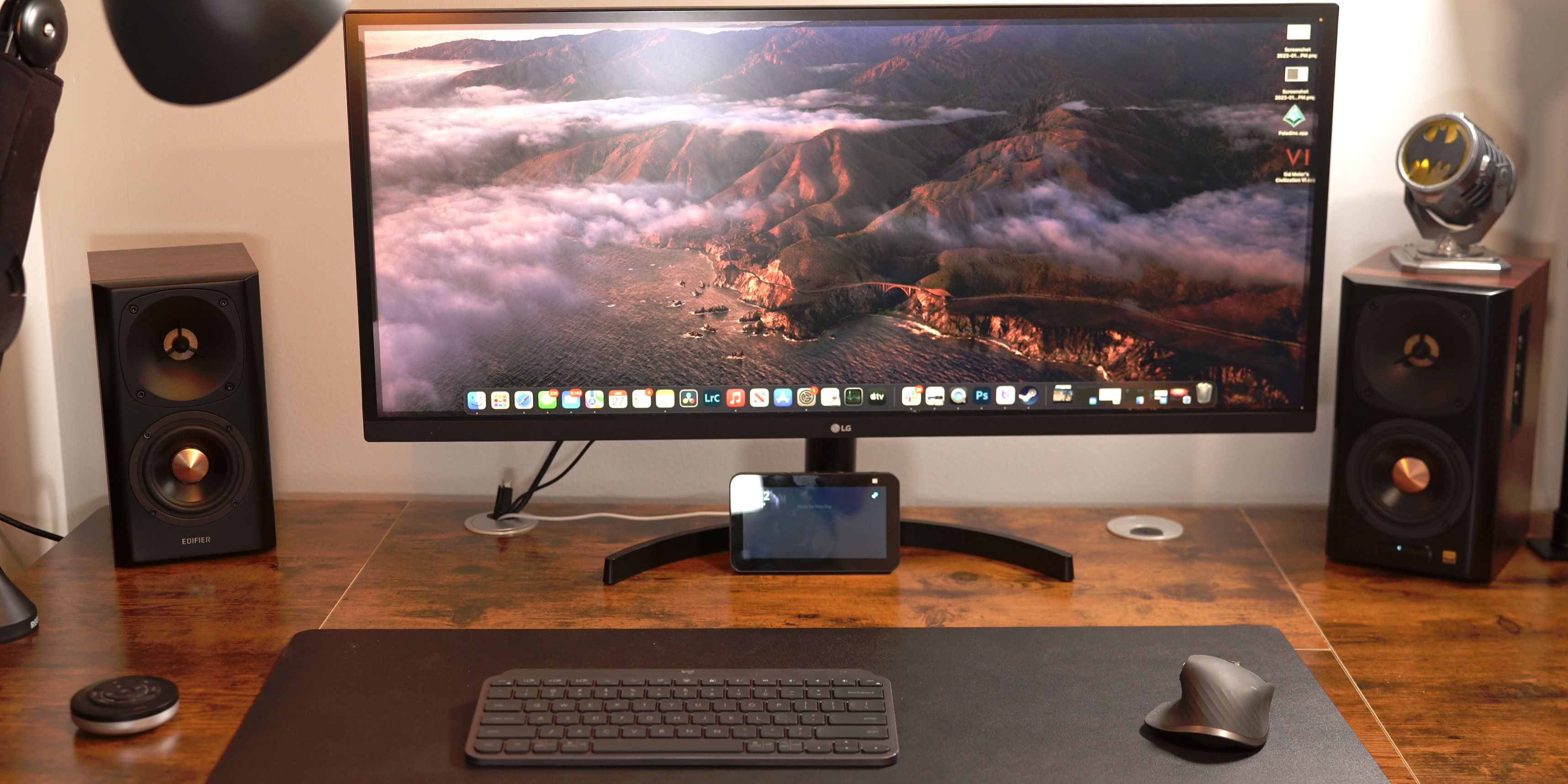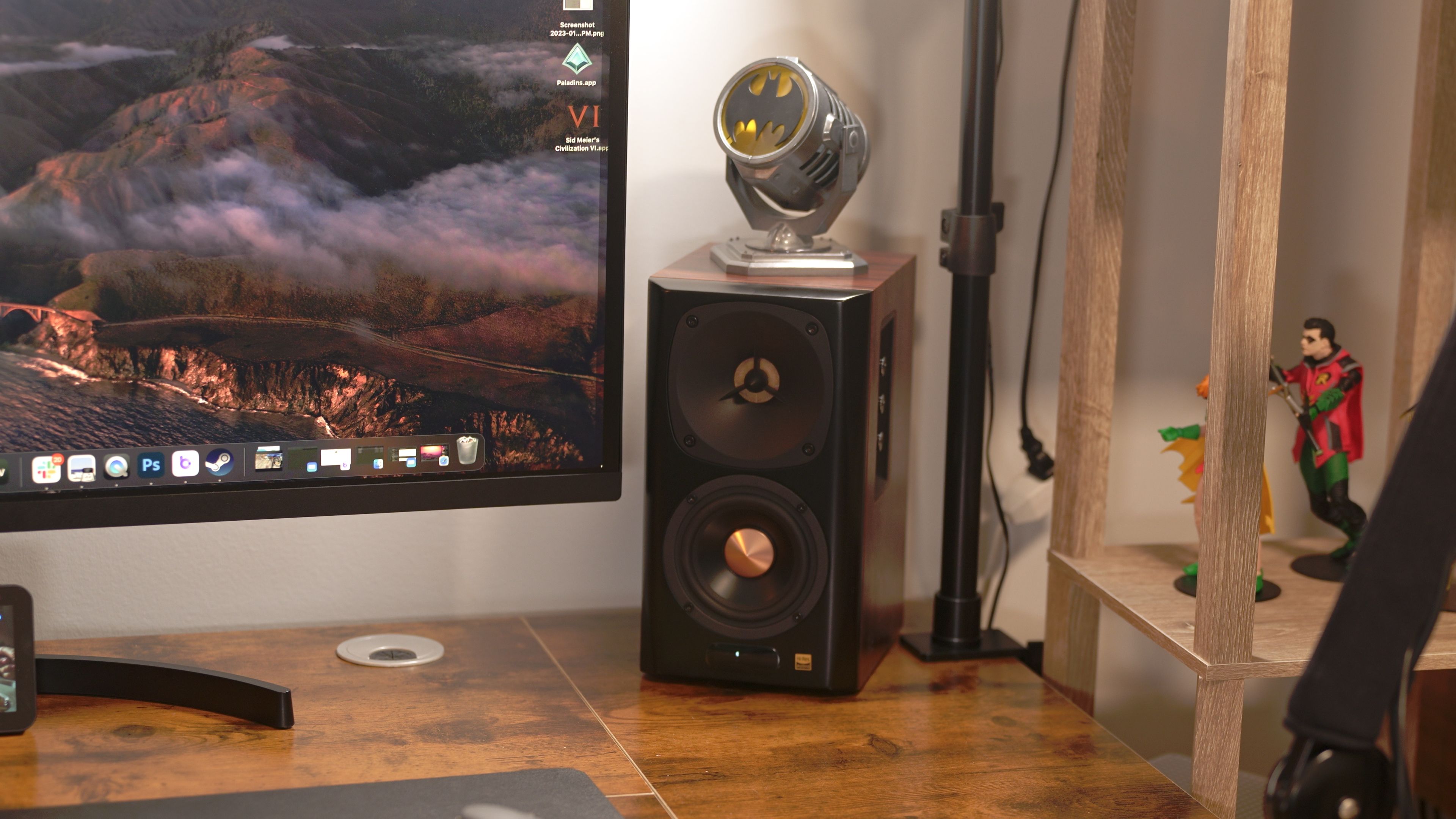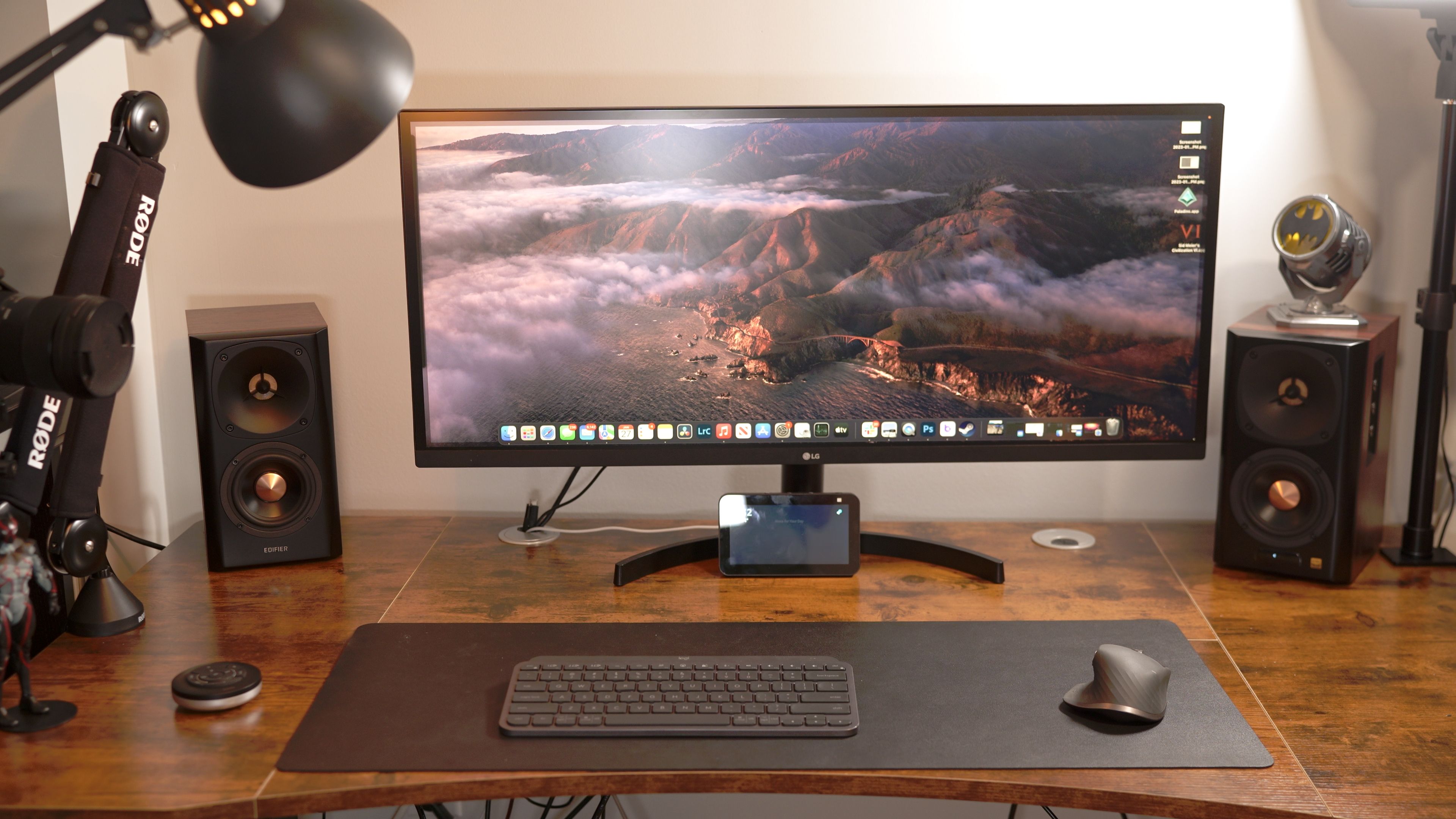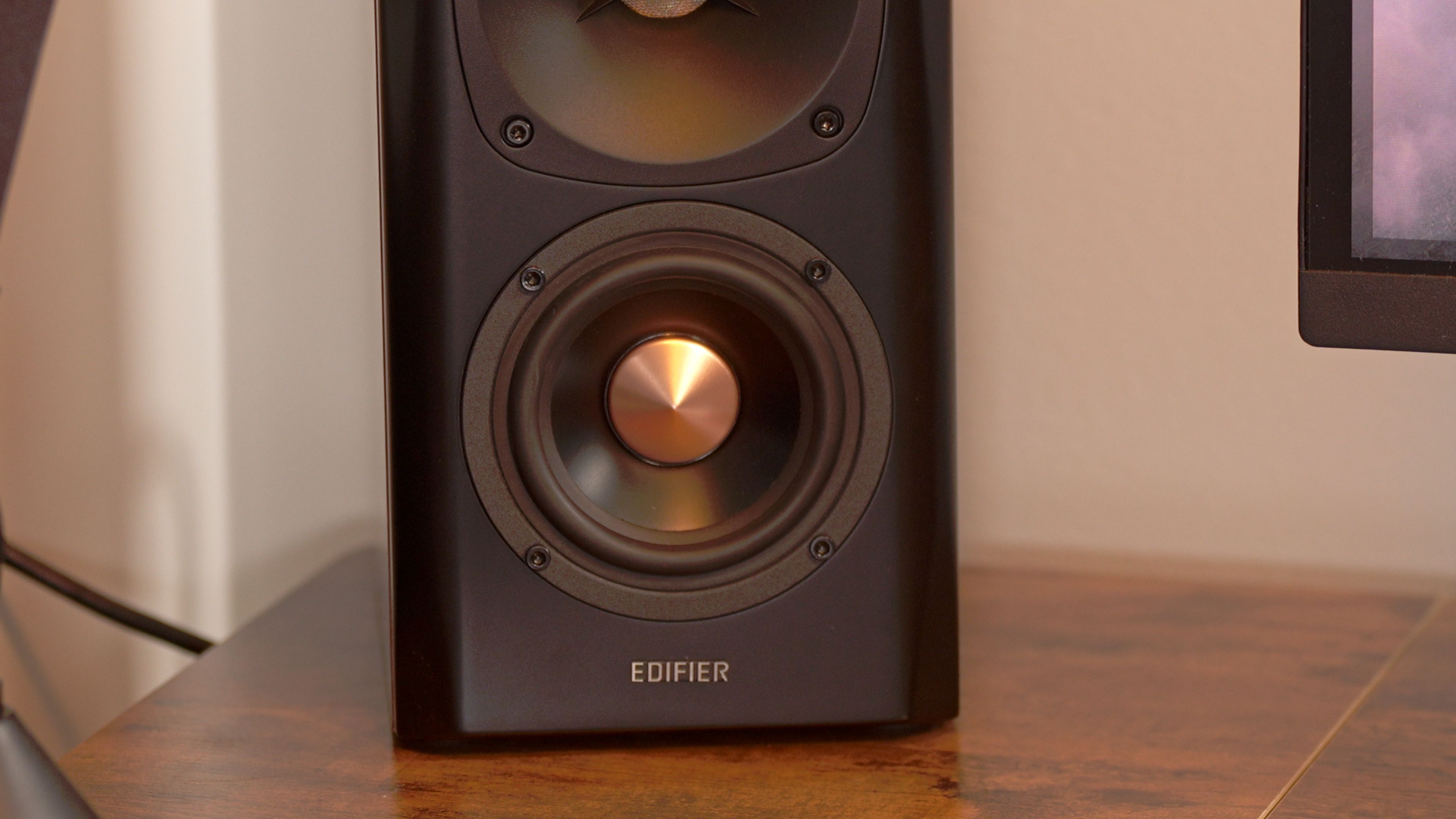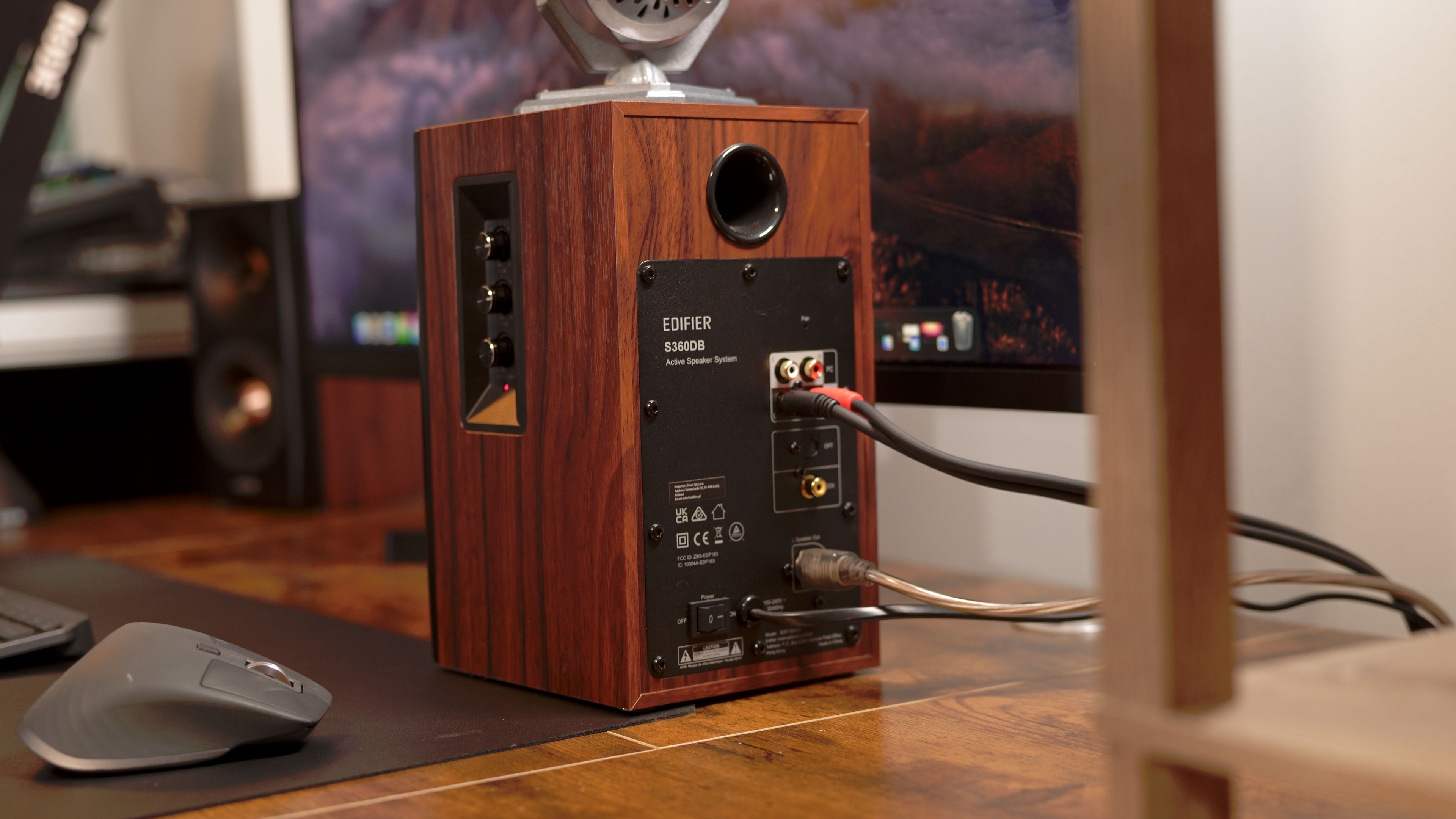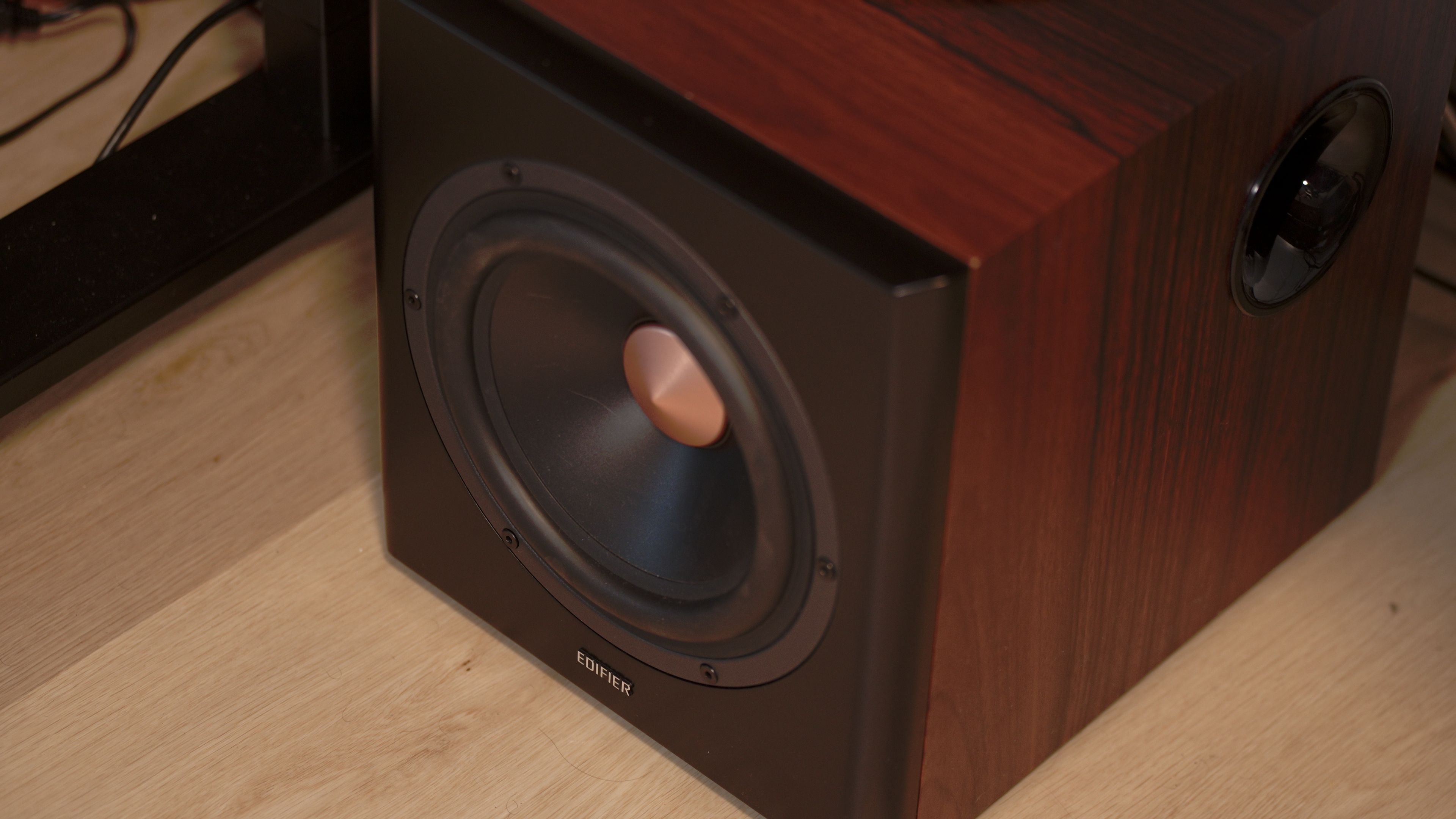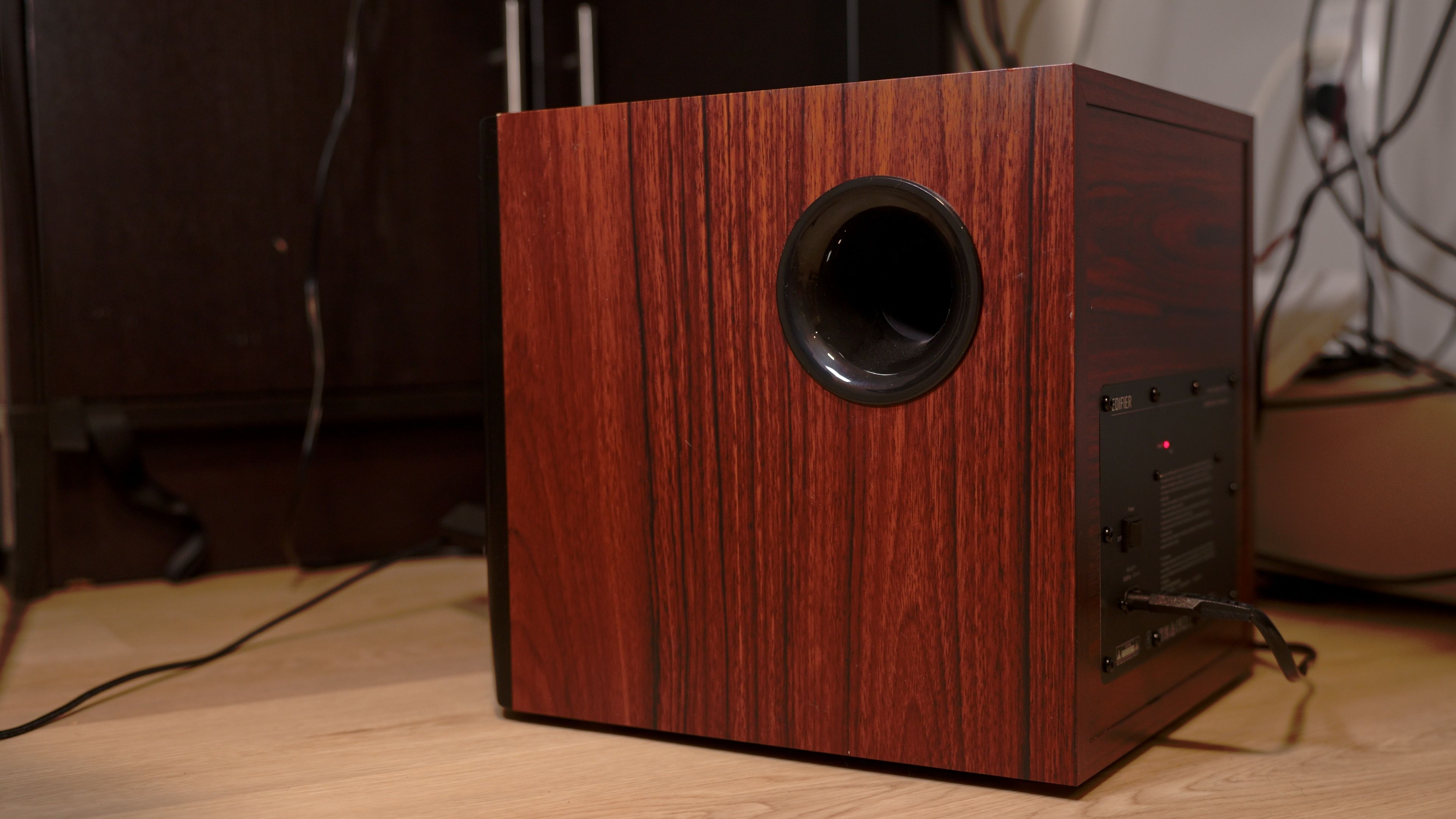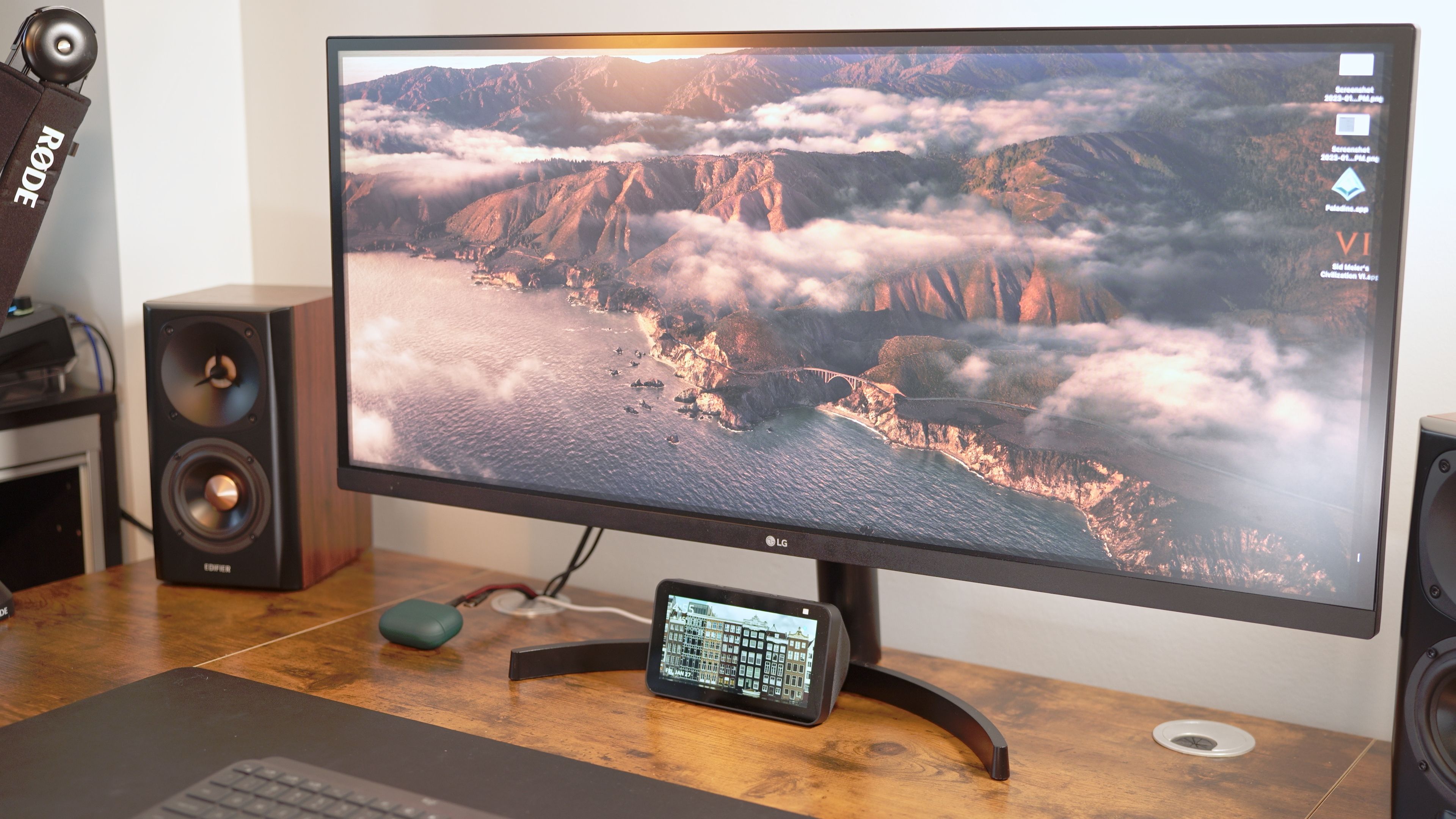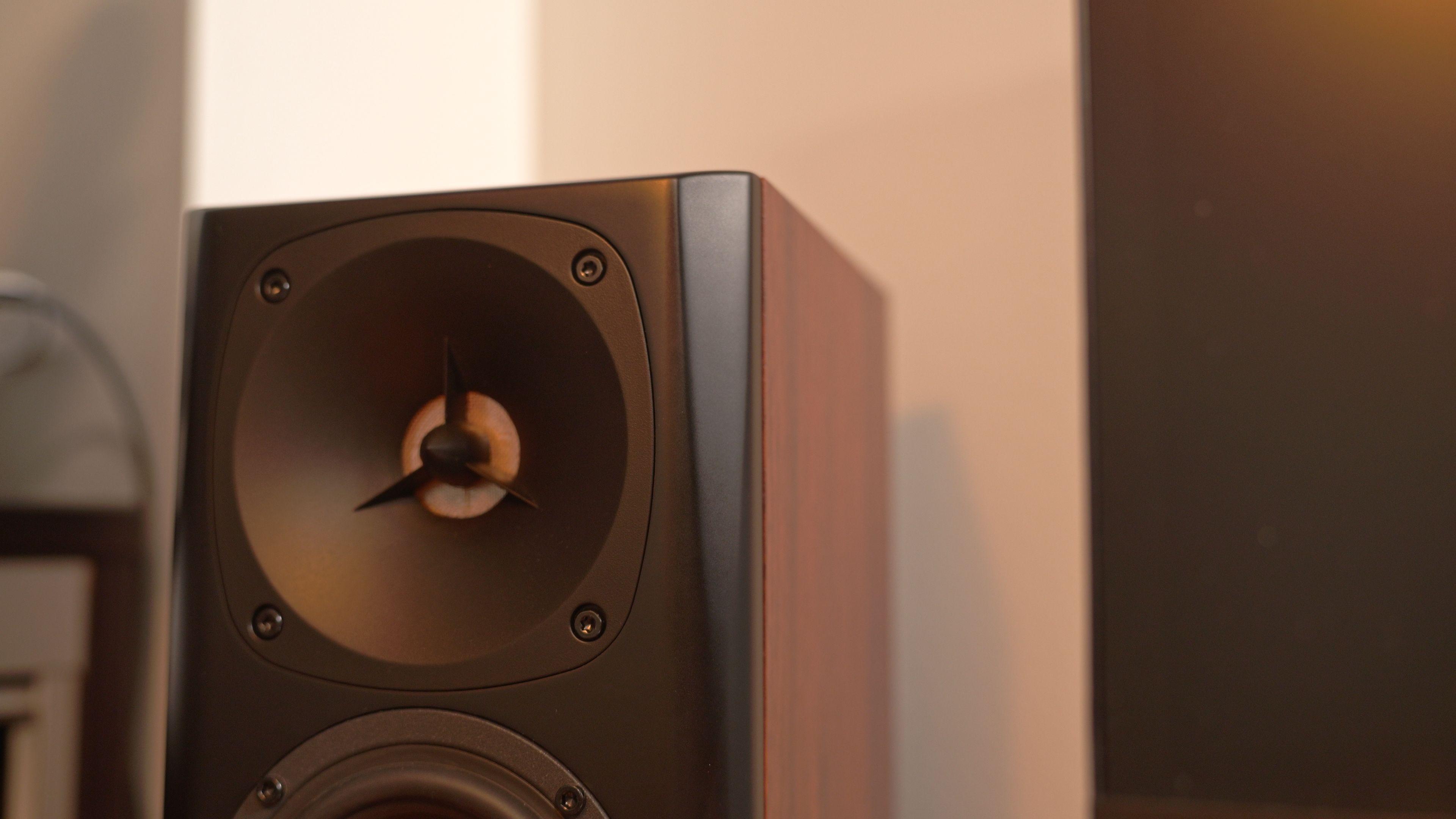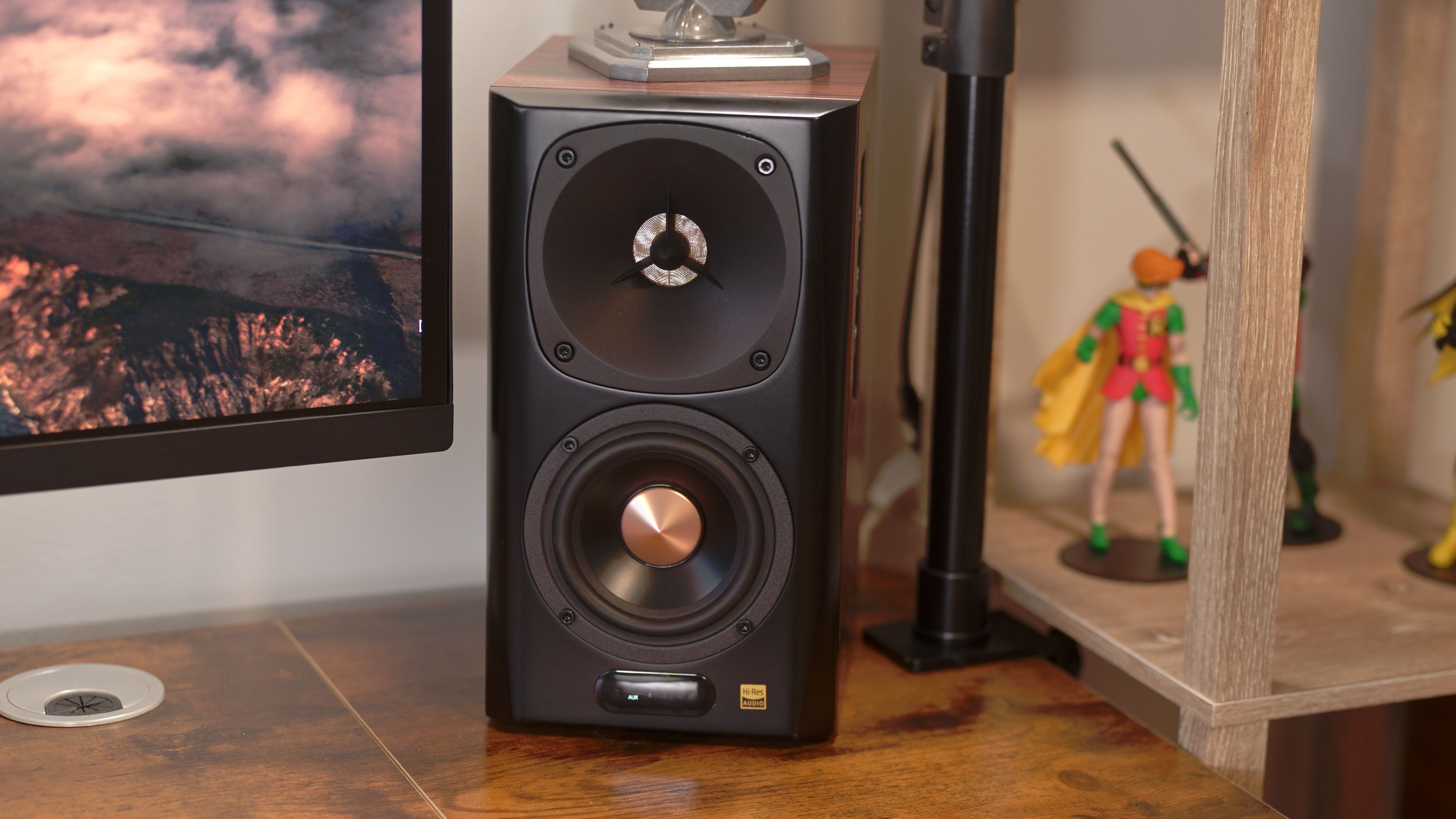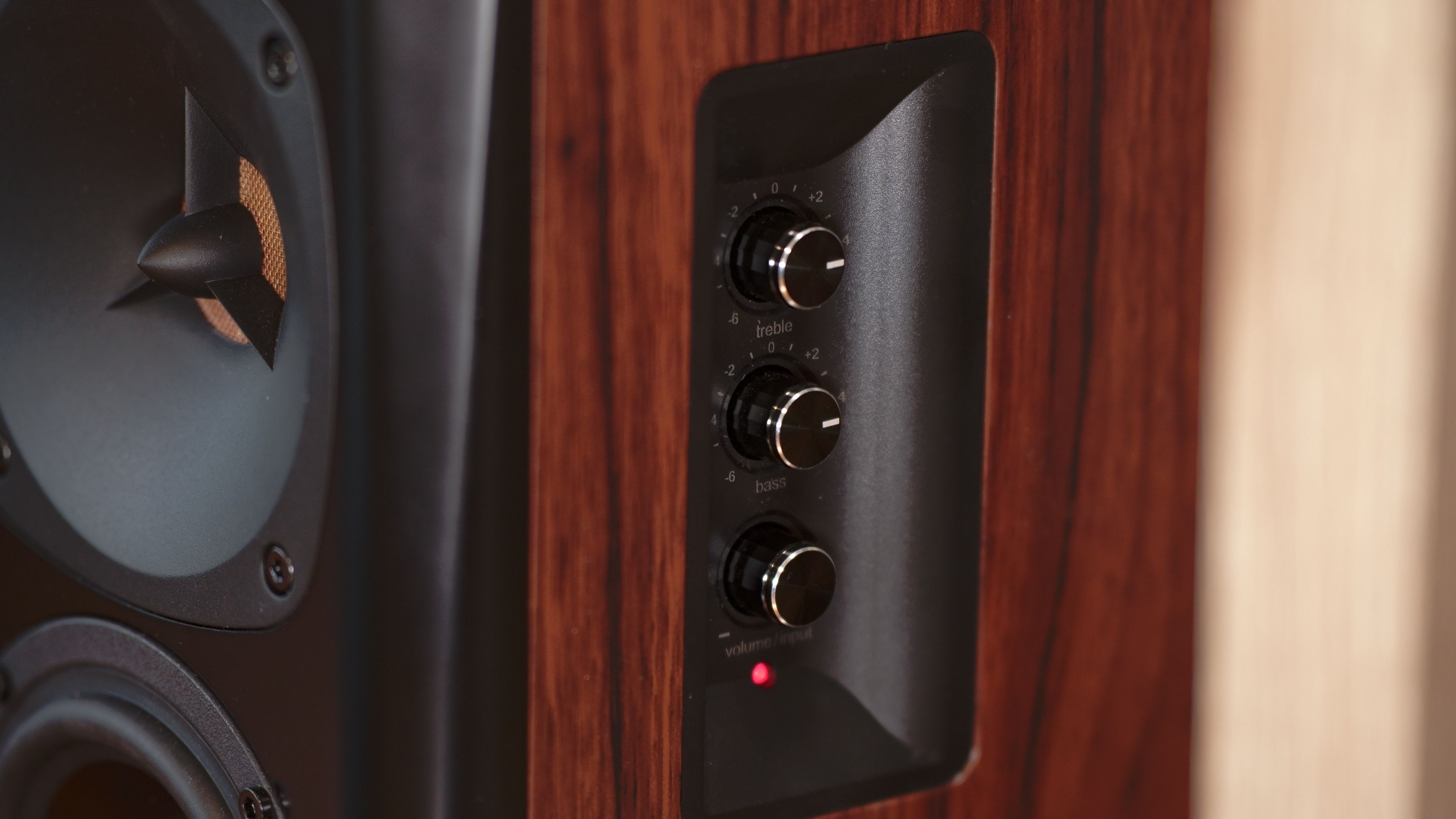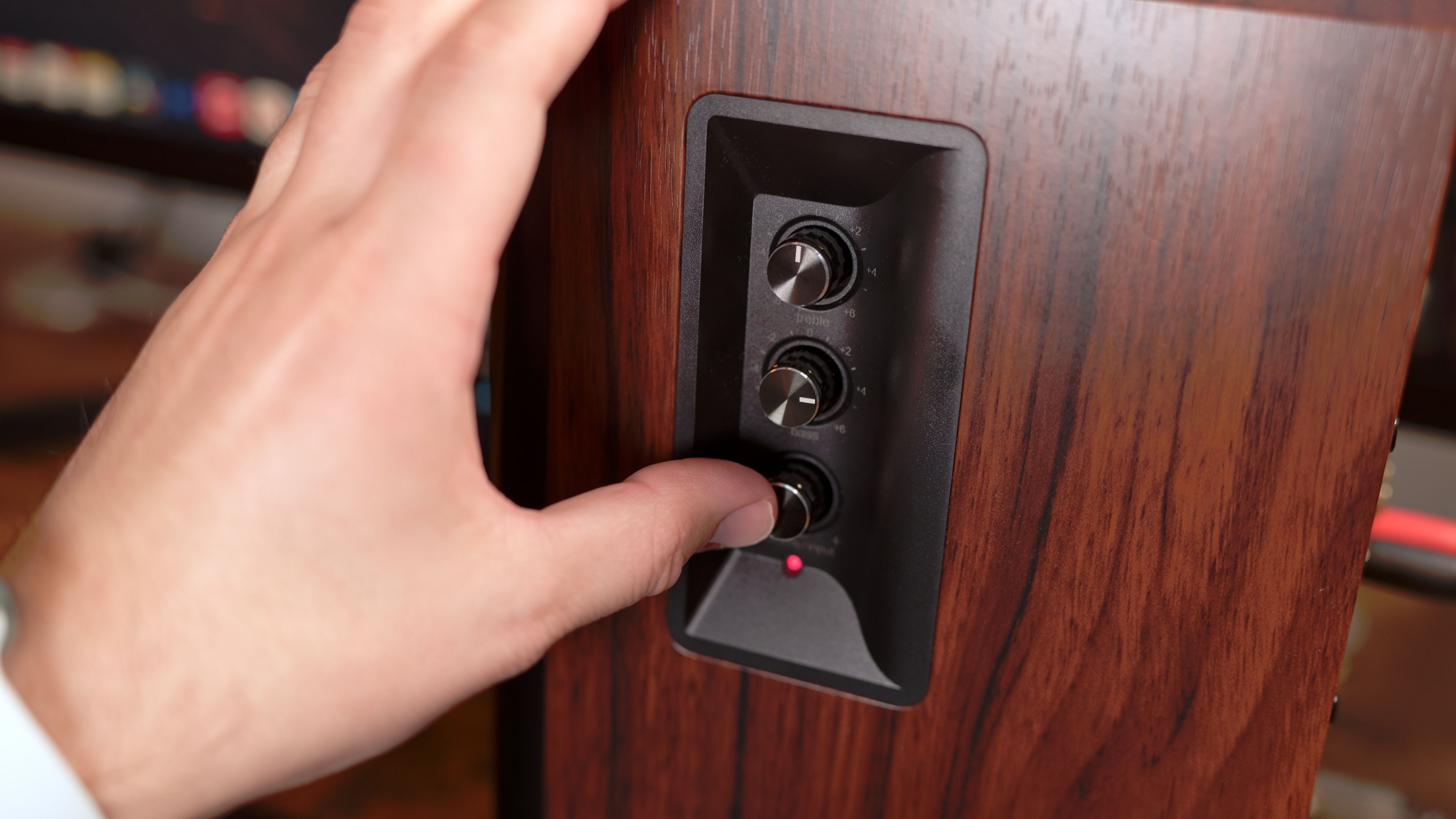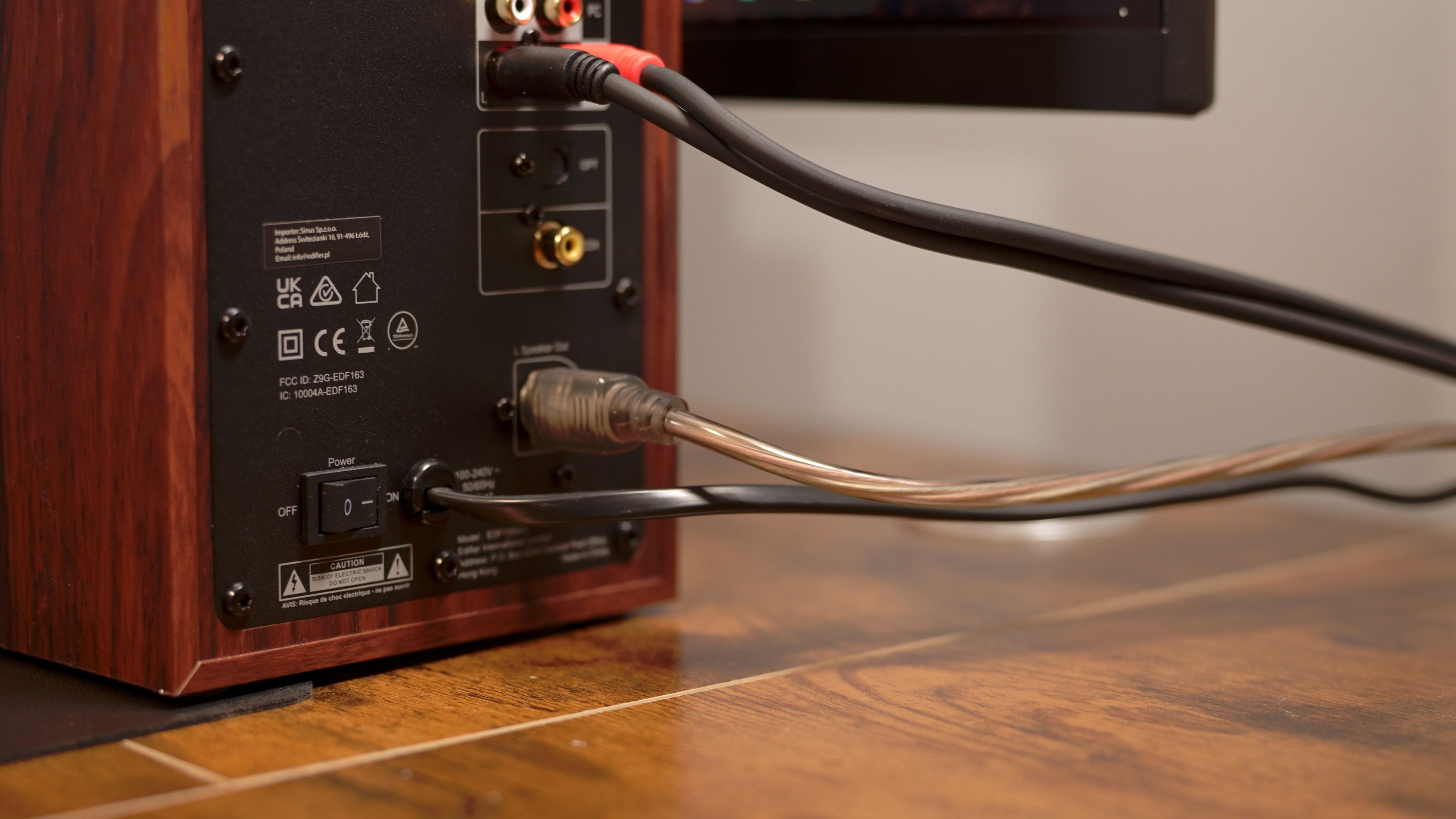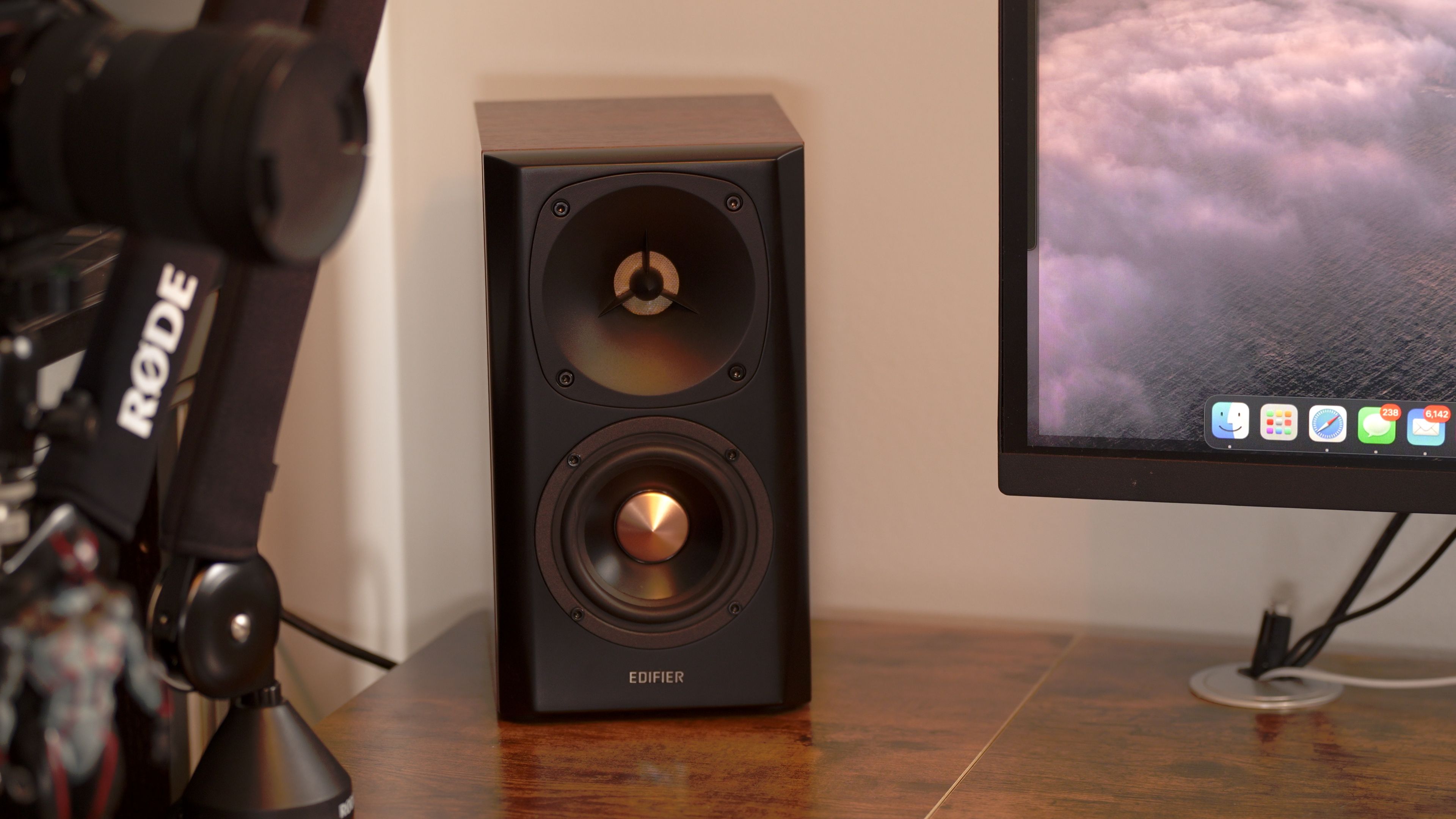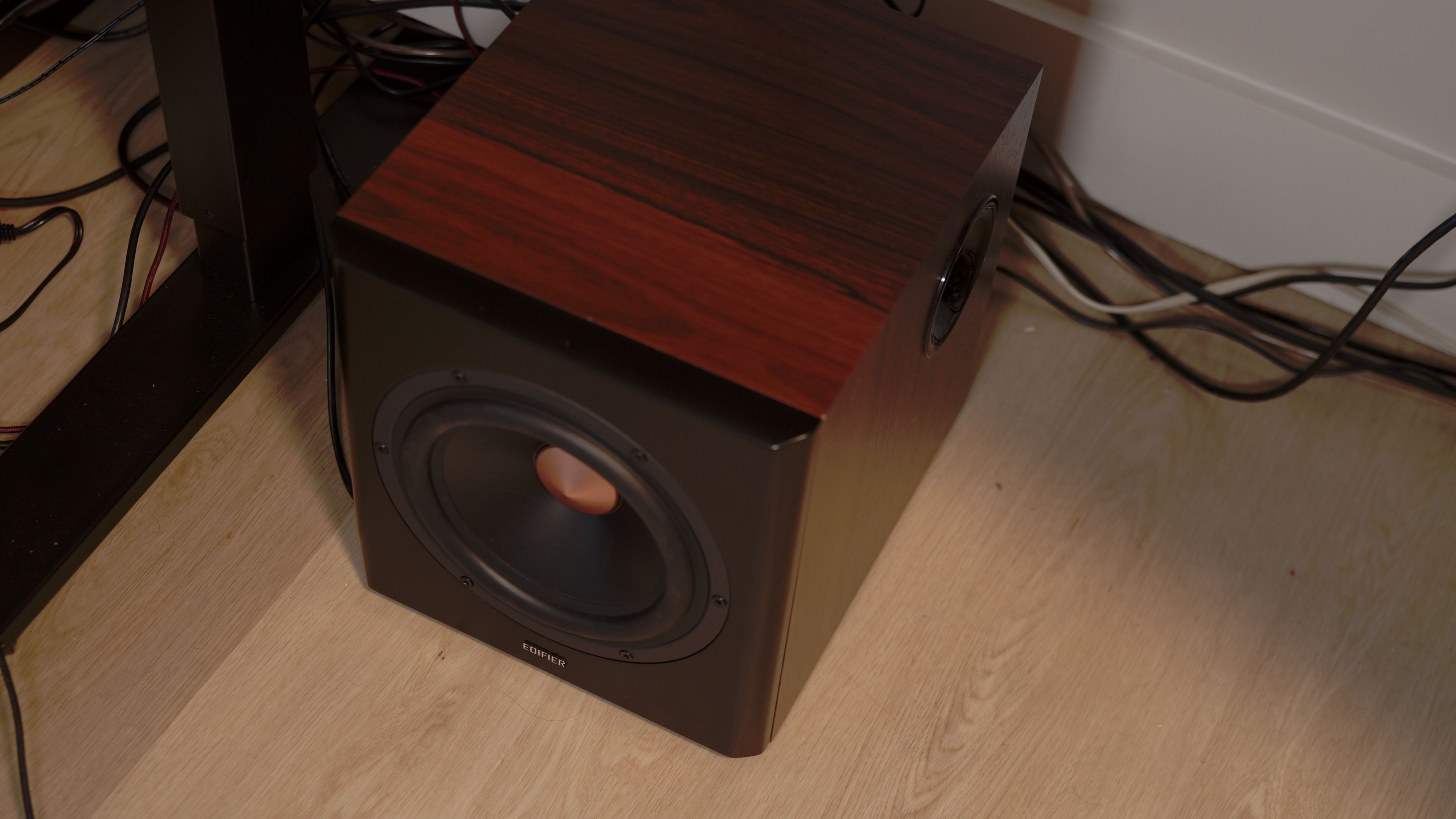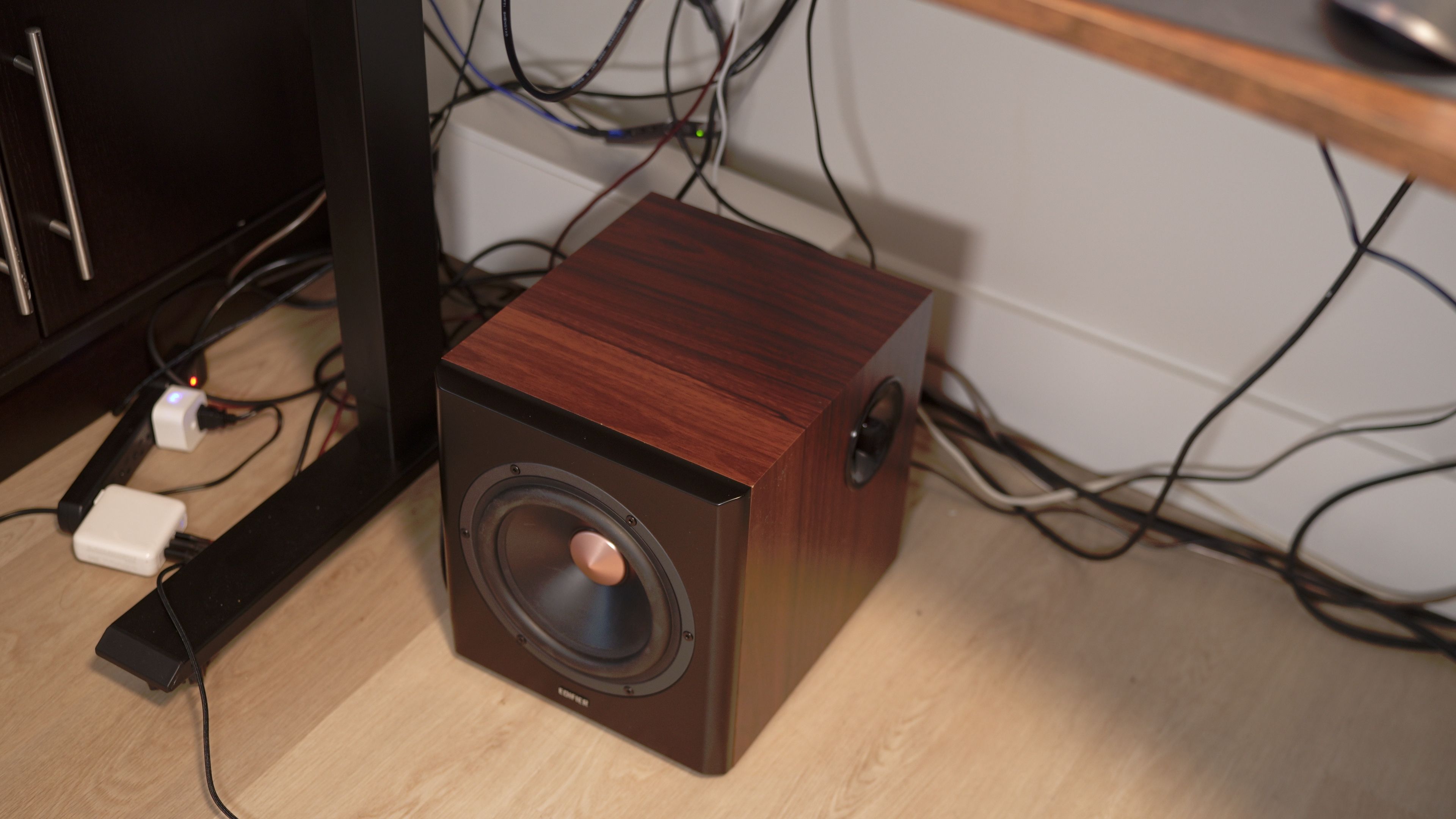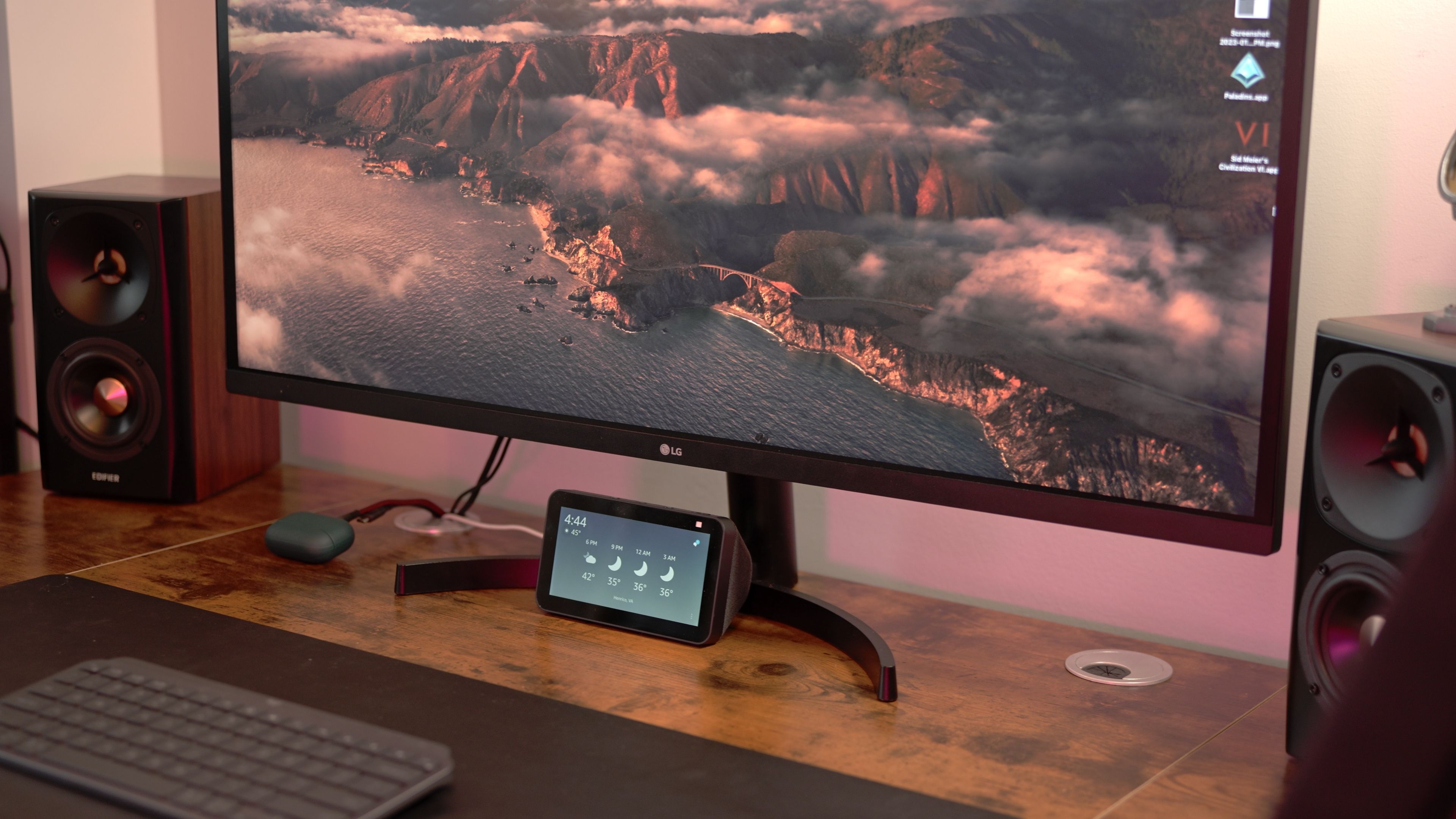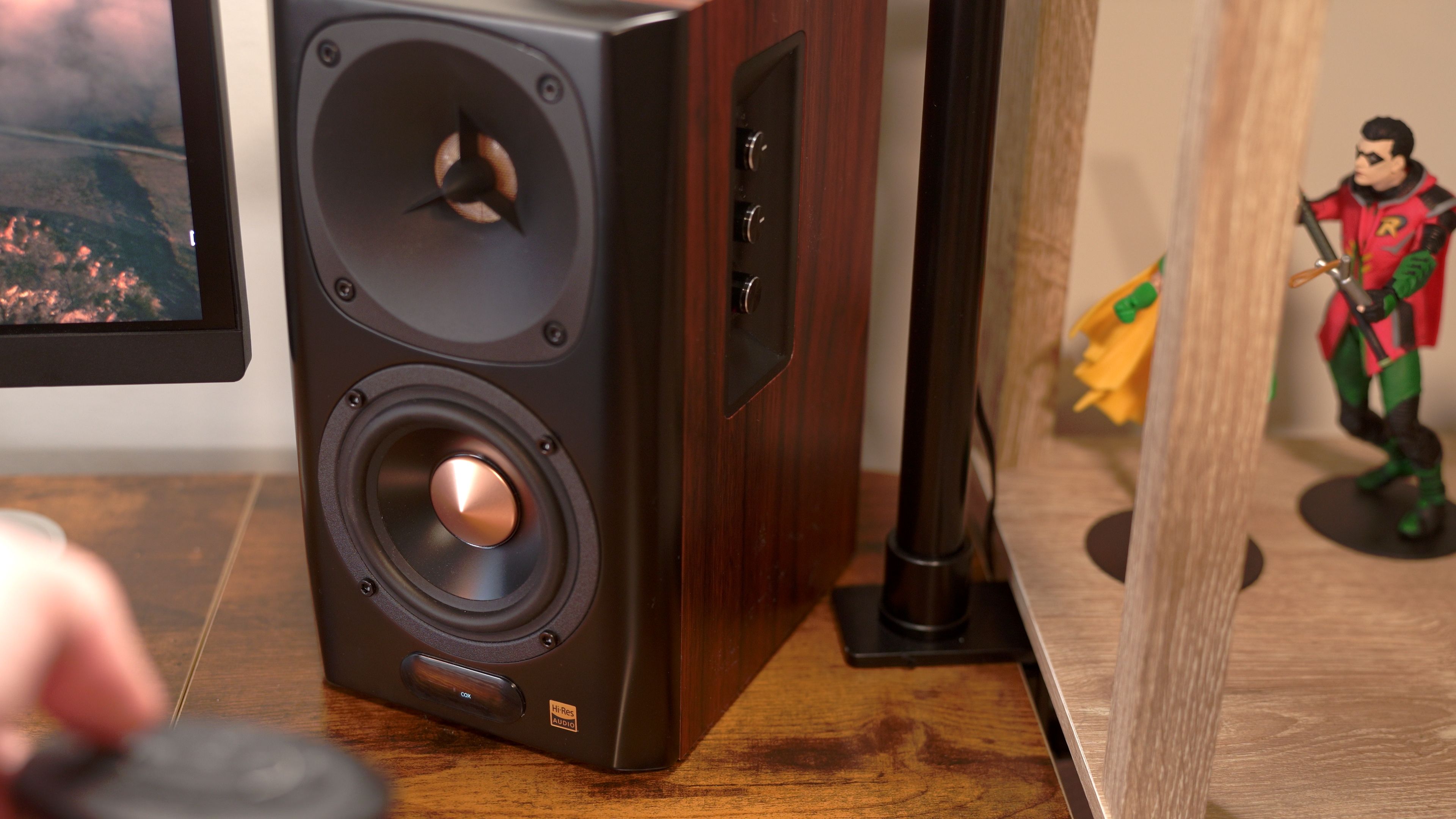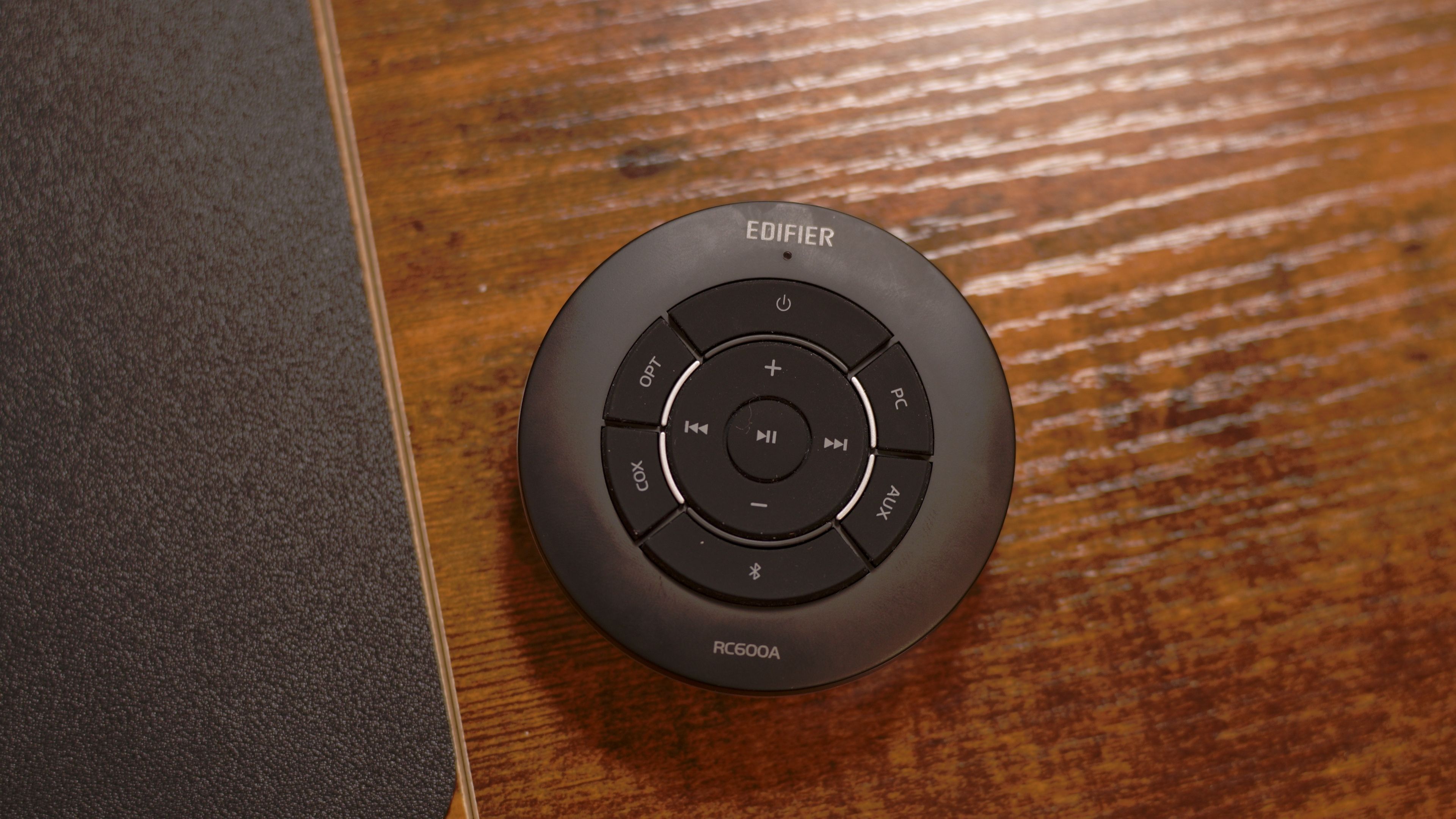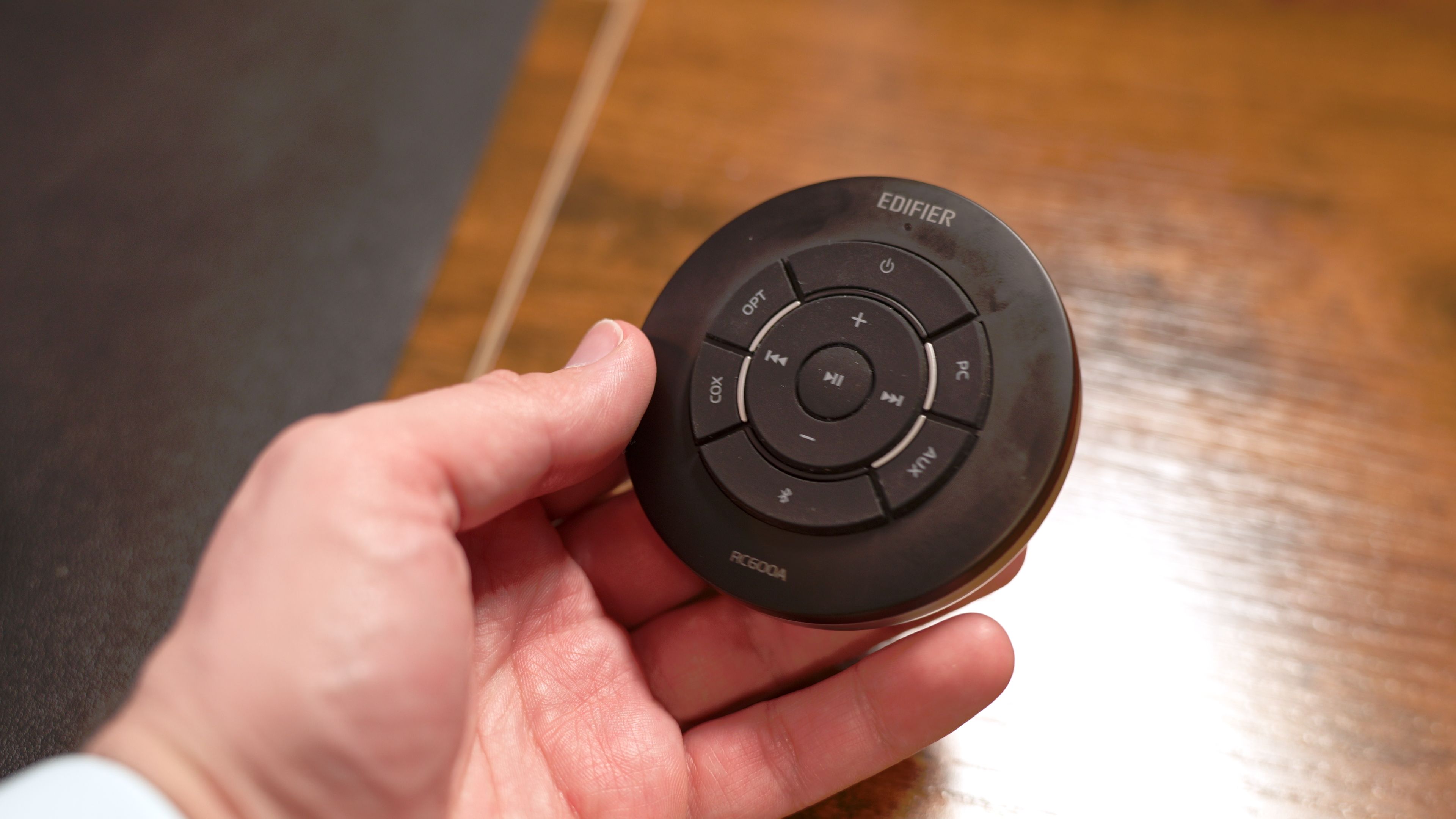Edifier S360DB
For less than $500, the Edifier S360DB is a power 2.1 speaker system that delivers excellent audio performance, connectivity, and design. It has a number of improvements over the older S350DB, including improved cable management and the wireless subwoofer. The Edifier S360DB is a great choice for anyone looking for a premium, powerful and versatile speaker system.
- Brand: Edifier
- Connectivity: PC, AUX, Optical, Coaxial, Bluetooth
- Power: 155W Total
- Driver Size: Bass unit: 8-inch (220mm), Mids+bass unite: 4-inch (105mm) x 2, Tweeter unit: Planar diaphragm tweeter x 2
- Frequency Response: R/L: 60Hz – 40KHz, SW: 40Hz – 150Hz
- Signal to Noise Ratio: R/L: ≥85dB(A), SW: ≥85dB
- Audiophile-grade sound performance
- Strong bass
- Wireless subwoofer with no latency
- Wooden design looks very premium
- Excellent wireless range
- Remote has limited features
- Right speaker has non-removable power cable
- No NFC
The Edifier S360DB is a 2.1-channel speaker system with a sleek and modern wood-finish design that provides high-quality audio for small to medium-sized rooms. This is the upgraded version of its predecessor, the S350DB, delivering improved performance, build quality, and connectivity.
At $500, this is a premium choice of desktop or studio speakers that won't disappoint with its clarity or bass performance. Overall, the Edifier S360DB is a great choice for anyone looking for a high-quality speaker system that can be used for audio monitoring, listening to music, gaming, or watching content.
Design and Features
The Edifier S360DB speakers look great and have excellent build quality throughout. On my dark brown wooden desk, the satellite speakers have a very similar wood finish on their top and sides that matches the appearance very well. While its front cover is made of plastic, it's perfectly complemented by the titanium dome tweeters, which with their screws and more aggressive styling, give the speakers a unique mix of industrial, modern, and retro looks.
The left and the right satellite speakers use Hi-Fi class planar diaphragm tweeters that have a three fin design very reminiscent of the retro Douglas DC-3 propeller-driven airliner.
Below those are 4-inch aluminum mid-range drivers that have a bronze exterior finish. These are 0.5 inches larger than the previous Edifier S350DB. Both satellite speakers measure 140 x 253 x 177mm, while the subwoofer measures 275 x 299 x 322mm.
Right Speaker
With its built-in amplifier, the right speaker acts as the primary speaker and features an infrared receiver. Located on its face at the very bottom is a small display that identifies the current input. It's rather simple but gets the job done. Taking it a step further, I feel like Edifier could have snuck in extra features, such as displaying your volume when you make adjustments on the remote, or maybe even showing a visual EQ for the audio playing.
On its right-hand side, the right speaker has three knobs located vertically. From top to bottom: treble, bass, and volume. The first two knobs have adjustments from -6 to +6 with a fixed middle position that they snap to. In contrast, the volume knob does not have a fixed 0 or 100. Instead, it can be turned infinitely in either direction. However, each turn clicks to identify an increase or decrease.
Additionally, pressing on the volume knob also allows you to switch your input, though it's not as convenient as using the remote, as you have to cycle through each option. Below the volume is a red light indicating that the speaker is powered.
As this is our active speaker, most of the connectivity is done here, which helps with cable management. Located on its back, we have the connections: PC, Aux, Optical, Coaxial, and Left Speaker Out.
On the bottom left-hand side, we have a power switch to power down the system completely, and to its right, a non-removable power cord. Unfortunately, the power cable is built into the speaker as which makes it more difficult to repair or replace if it ever gets damaged.
Left Speaker
Unlike the right speaker, the left satellite has the Edifier logo in place of the information display on the right. Aside from its Speaker Input on the back, the left speaker does not have any controls or additional connectivity. Besides those differences, the left speaker looks identical to the right.
Subwoofer
The dark wooden sides and front black plastic design carry over to the subwoofer, which has an 8-inch front-firing speaker and a bass reflex port on the right side for vibration-free bass. While the satellite speakers are also large, the subwoofer requires a little extra thought with its placement in your room.
Located against a wall under my standing desk, which has rather narrow legs, the subwoofer is bulky, taking up almost half the depth and one-third of the width available underneath.
At times this prevented me from rolling my chair as far forward as I would like, and usually also means that I sit more towards the right side of my desk, rather than in the middle as I previously did. With a smaller office, this is the only practical spot I could place the subwoofer.
As this is a wireless subwoofer, it has just one cable on the back for power. This makes it much easier to place in different parts of your room without it being too obtrusive. Similarly, the previous model used the subwoofer for all of its connectivity, which would limit where it could be placed if you didn't want cables running everywhere.
The subwoofer wirelessly communicates with the active right speaker using the 5.8GHz EV01S Module, which transmits uncompressed wireless digital audio without delay. In addition to the larger tweeters, this is a significant upgrade compared to the older S350DB and one of the best new features. Connectivity remained perfect throughout all my tests, even when placing the subwoofer about 10 feet away from the satellite speakers. The subwoofer never cut out, experienced delays, or had degraded quality.
What Is a 2.1 Speaker System, and Should You Choose One?
A 2.1 speaker system consists of two satellite speakers and one subwoofer. The two satellite speakers are responsible for reproducing the mid-range and high-frequency sounds, while the subwoofer handles the low-frequency bass sounds.
2.1 configurations are very popular for smaller setups because they provide a good balance between stereo and bass and have plenty of power to fill those spaces well. This makes them a great choice for listening to music, gaming, as well as consuming other media. The addition of a good subwoofer creates a more dynamic and powerful audio experience when compared to a 2.0 system.
It's not always necessary to spend a lot of money to get a good 2.1 speaker system. However, you generally get better audio quality and more features.
Retailing for $500, the Edifier S360DB is considered a more expensive and premium choice. You can find several 2.1 speaker systems for under $100, but they usually have limited features and not as good audio quality, largely due to their smaller size and weaker drivers.
Mid-range 2.1 speaker systems typically cost between $100 to $300 and generally offer better audio quality—best for desktop and smaller room setups. As with other high-end 2.1 speaker systems that cost over $300, the Edifier S360DB is considered more audiophile-grade, with more premium sound quality and advanced features and connectivity options.
While these 2.1 speaker systems can sound incredible, for larger rooms, or a more immersive experience, especially when creating a home theater, that's where you may want to consider a 5.1 or 7.1 system like the Sony CS-Series. With more speakers placed around a room, these larger systems give you a greater sense of separation between channels and a more realistic sense of the location of sounds. This can sound incredible with your favorite movies or shows.
Of course, size and cost are big deciding factors, with good 7.1 systems starting at around $1000 and requiring much more floor space for all the additional speakers. In general, though, a 2.1 system is the best choice for a desk or bookshelf setup as it strikes a good balance between size, quality, and value.
Setup and Connectivity
The Edifier S360DB is very easy to set up. In its box, you'll find the power cable for the subwoofer, an audio cable to connect the two satellite speakers, and the RC600A remote. Simply connect the satellite speaker, then supply power to the primary speaker and the subwoofer.
Bluetooth
The Edifier S360DB uses Bluetooth V4.1 with aptX. This provides high-quality streams with low latency. Switching to the Bluetooth input on the speaker enables the speakers to be searched for and paired with. Pairing is quick, and I can reliably play music from my connected phone and move anywhere in my small apartment without a drop in signal.
With its $500 price tag, it's a little unfortunate that NFC isn't available. More expensive speakers tend to offer NFC, which allows you to touch the speaker with an NFC-compatible smartphone to wake the speakers and initiate the Bluetooth connection automatically. This isn't a huge inconvenience, but it would have been nice to see it here.
RC600A Remote
I have mixed feelings about the RC600A wireless remote. While I can use the remote from any part of my room, I did notice, however, that the receiver can easily be obstructed, even by smaller objects, like action figures, that stood directly in front of it. The awkward placement of the infrared receiver means it needs a direct line of sight to work reliably.
The remote has a circular shape that is about 3.5 inches wide and half an inch thick. It has a light gray plastic bottom which houses its CR2025 battery. The top cover is made of black plastic that surrounds the rubberized controls are also laid out in a circular pattern. The controls are easy to use and are clearly labeled. The remote has buttons for power, volume, playback, and inputs.
But you aren't able to see which input is active, nor can you see your volume levels. Similarly, it omits the treble and bass options, which means you will have to get up from your couch to go and tweak these options.
The design is certainly unique, but I think I would have preferred a more traditional rectangular design.
With many remotes switching over to USB-C for easier charging, the use of a coin cell battery makes it feel more dated than it is. It has a good weight to it, but the overall plastic build feels a tad cheap and is prone to smudging on its top cover.
Sound Quality
The sound quality is impressive, to say the least. No matter what I listened to, everything sounded clear, balanced, and dynamic, with plenty of bass and treble, even at its default settings. The massive 75W 8-inch subwoofer perfectly complements the two satellite speakers without overpowering or distorting the mids or highs.
If you want a more balanced sound, keeping the bass and treble set between 0 to -2 does a good job. This makes it good for audio monitoring and mixing, which is what I primarily use these speakers for. When it comes to consuming media, I liked both at around +4, though, in truth, the bass is so powerful that if I didn't want to be obnoxious to my neighbors, I would limit the bass to +2 at most.
When listening to bass-heavy hip-hop tracks like Yelawolf's Pop the Trunk, the intro hi-hats with the piano in the background are crisp and eerie. Once the bass comes in, it hits hard without any distortion. There's no question if you like bass, these get the job done.
With more mellow post-rock tracks like Dunes by This Will Destroy You, the layers of synth and guitar are easy to identify and never feel jumbled. When the song crescendos with its heavier distorted guitars and bass, the speakers still manage not to sound muddy or lose detail.
Do You Have $500 to Spend on Desktop Speakers? Buy These
The Edifier S360DB is probably one of the best-sounding 2.1 speaker systems you can buy for under $500.
While it is expensive, few other systems at this price point offer the same audio performance, connectivity, and design. If you want to save a bit, you can opt for the older S350DB, though you will lose out on some of the conveniences of the newer model, including improved cable management and the wireless subwoofer.
The Edifier S360DB is a great choice for anyone looking for a premium, powerful and versatile speaker system.

